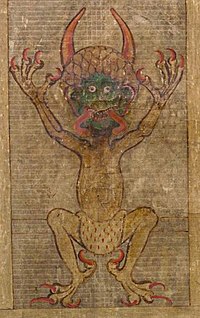Codex Gigas
The Codex Gigas is one of the largest manuscripts in the world, (hence Gigas, Greek for 'giant'). It was created in the early 13th century in the Benedictine monastery of Podlažice in Bohemia, and is now in the National Library of Sweden, where two librarians are needed to lift it. It is also known as the Devil's Bible due to a large illustration of the devil on the inside.
Appearance

The codex is contained in a wooden folder, covered with leather and ornamented with metal. At 92cm (36.2in.) tall, 50cm (19.7in.) wide and 22cm (8.6in.) thick it is the largest known medieval manuscript. It initially contained 320 vellum sheets, though eight of these pages were subsequently removed. It is unknown who removed the pages or for what purpose but it seems likely that they contained the monastic rules of the Benedictines. The codex weighs nearly 75 kg (165lbs.), the vellum used having been prepared from the skins of 160 asses.
History
The codex was created in the Benedictine monastery of Podlažice near Chrudim, which was destroyed during the 15th century. Records in the codex end in the year 1229. The codex was later pledged to the Cistercians Sedlec monastery and then bought by the Benedictine monastery in Břevnov. From 1477-1593 it was kept in the library of a monastery in Broumov until it was taken to Prague in 1594 to form a part of the collections of Rudolf II.
On the end of the Thirty Years' War in the year 1648, the entire collection was taken by the Swedish army as plunder. Since 1649 the manuscript has been kept in the Swedish Royal Library in Stockholm. The site of its creation is marked by a maquette in the town museum of Chrást.
The codex is due to be moved back to Prague for a six week exhibition in early 2007.
Content
The Codex includes the entire Latin Bible in a pre-Vulgate version, Isidore of Seville's Etymologiae, Josephus' Antiquities of the Jews, Cosmas of Prague's Chronicle of Bohemia, various tractates (from history, etymology and physiology), a calendar with necrologium, a list of brothers in Podlažice monastery, magic formulae and other local records. The entire document is written in Latin.
The manuscript includes illuminations in red, blue, yellow, green and gold. Capital letters are elaborately illuminated, frequently across the entire page. The codex has a unified look as the nature of the writing is unchanged throughout, showing no signs of age, disease or mood on the part of the scribe. This may have led to the belief that the whole book was written in a very short time (see Legend).
Page 290 (otherwise empty) includes a unique picture of the devil, about 50cm tall. Several pages before this are written on a blackening vellum and have a very gloomy character, somewhat different from the rest of the codex.
Legend

According to legend the scribe was a monk who breached his monastic code and was sentenced to be walled up alive. In order to forbear this harsh penalty he promised to create in one single night a book to glorify the monastery forever, including all human knowledge. Near midnight he became sure that he could not complete this task alone, so he sold his soul to the devil for help. The devil completed the manuscript and the monk added the devil's picture out of gratitude for his aid.
Despite this legend the codex was not forbidden by the inquisition and was studied by many scholars.
References
- Bártl, S., Kostelecký, J.: Ďáblova bible. Tajemství největší knihy světa, Paseka, 1993. ISBN 80-85192-64-0
- http://www.praguepost.com/P03/2005/Art/1020/tempo1.php
- http://www.radio.cz/en/article/71331
- Codex Gigas in The European Library: treasure of national library of Sweden
